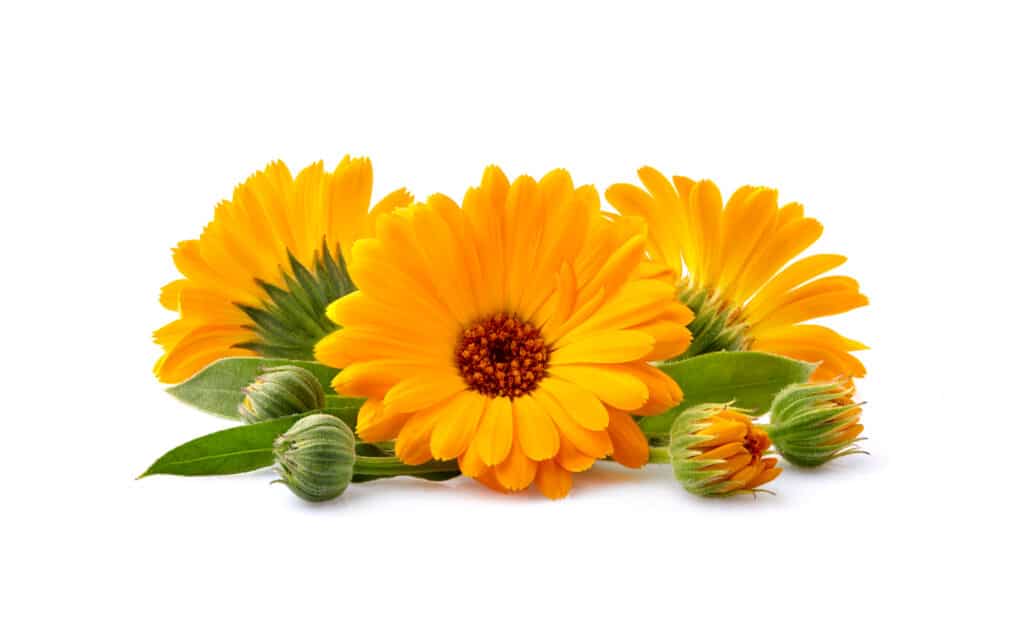They may look similar to one another, but there are a number of differences between a calendula vs marigold. Both members of the daisy family, calendulas and marigolds have some undeniable traits that they share, but they are indeed more different than you think. But what might some of these differences be, and how can you learn how to tell these flowers apart?
In this article, we will compare and contrast calendulas with marigolds so that you can fully understand what makes both of these flowers special. In addition, we will give you some hints as to how you can best tell them apart based on their physical description alone, as well as how they best grow. Let’s get started and learn all about these two plants now!
Comparing Calendula vs Marigold

| Calendula | Marigold | |
|---|---|---|
| Plant Family and Genus | Asteraceae, Calendula | Asteraceae, Tagetes |
| Description | Petals come in a variety of warm colors, but form an even layer of petals around a central head. Leaves are rounded and long on most varieties. Reaches anywhere from 1-3 feet tall and wide, depending on planting conditions. | Petals come in a variety of warm colors, but appear in clusters around a central head. Leaves are jagged and fernlike, with multiple clusters under a single bloom. Reaches anywhere from 1-6 feet in height and width, depending on planting conditions. |
| Uses | A great garden plant, but also prized for its culinary and medicinal uses. Occasionally used to dye items naturally | Fantastic in the garden for pest prevention, but also works well to attract butterflies and bees. Often used to dye things naturally |
| Origin and Growing Preferences | Native to Africa and Europe; grows best in spring or fall, avoiding hot summer sun exposure. Full sun or partial shade works best, with plenty of water for new seedlings | Native to North and South America; extremely easy to grow and very drought tolerant. Plant in full sun and make sure you give them plenty of water, but growing from seed is simple |
| Special Features and Fun Facts | Frequently used in ancient ceremonies and magical potions! | Frequently used in Day of the Dead remembrance celebrations! |
Key Differences Between Calendula vs Marigold

Marigolds have multiple layers of crumpled petals surrounding a central head, while calendulas grow with an even layer of petals around a central head.
©EQRoy/Shutterstock.com
There are a number of key differences between calendulas and marigolds. While calendulas are also known as marigolds, marigolds are their own distinct species. The seeds of the calendula plant are c-shaped, while the seeds of the marigold plant are long and narrow. In addition, marigold plants are smooth and soft to the touch, while calendula plants are sticky. Finally, calendula plants are edible, while marigold plants are toxic.
Let’s address all of these differences and a few more in detail now.
Calendula vs Marigold: Classification
It is interesting to note that the calendula plant was originally known as the marigold plant, but both are now classified as their own unique species. For example, both and marigolds belong to the aster or daisy family, known as Asteraceae. But calendula is classified under the calendula genus, while marigolds are classified under the tagetes genus.
Calendula vs Marigold: Description

The seeds of the marigold plant are long and straight, while the seeds of the calendula plant are C-shaped.
©Yulia_B/Shutterstock.com
It might be difficult to tell the difference between marigolds and calendulas at first, but there are some significant traits that separate them from one another. For example, marigolds have multiple layers of crumpled petals surrounding a central head, while calendulas grow with an even layer of petals around a central head.
While calendulas and marigolds come in similar colors that are warm and golden, the leaves are very different on these two plants. For example, marigold leaves are fernlike and jagged in appearance, while calendula leaves are rounded and long. If you are able to touch both of these plants, the calendula plant is often sticky, while marigold plants are smooth. Finally, the seeds of the marigold plant are long and straight, while the seeds of the calendula plant are C-shaped.
Calendula vs Marigold: Uses

Marigold leaves are fernlike and jagged in appearance, while calendula leaves are rounded and long.
©Quang Ho/Shutterstock.com
Calendula and marigold plants have similar uses to one another, but there are some differences here as well. For example, given their beautiful colors, both calendula and marigold plants are used to dye things naturally. However, calendula plants are edible and frequently used medicinally, while marigold plants are toxic. Both of these plants are beautiful in the average garden, but marigold plants are fantastic at preventing certain pests while attracting others, something that calendula is not particularly known for.
Calendula vs Marigold: Origin and How to Grow
Despite their similarities in appearance, calendulas and marigolds originated in very different locations. For example, calendulas are native to Africa and Europe, while marigolds are native to North and South America. Both of these plants grow in a similar way, though calendulas prefer spring and fall weather, while marigolds thrive in the heat of summertime. Make sure these plants get plenty of water, but they both grow easily from seed and reseed every year!
Calendula vs Marigold: Special Features

Calendulas are native to Africa and Europe, while marigolds are native to North and South America.
©TatianaMishina/Shutterstock.com
Calendula and marigold plants are interesting because of their potentially magical origins. For example, calendula was frequently used in ancient times, both in Greek and Roman ceremonies as well as magical potions and remedies. It was frequently utilized by witches in various witchcraft rituals, including seeing fairies and finding true love. Marigolds weren’t quite utilized in this capacity, but they are considered a key flower in Day of the Dead ceremonies in Mexico, making them culturally significant today.
The photo featured at the top of this post is © Yulia_B/Shutterstock.com
Thank you for reading! Have some feedback for us? Contact the AZ Animals editorial team.






